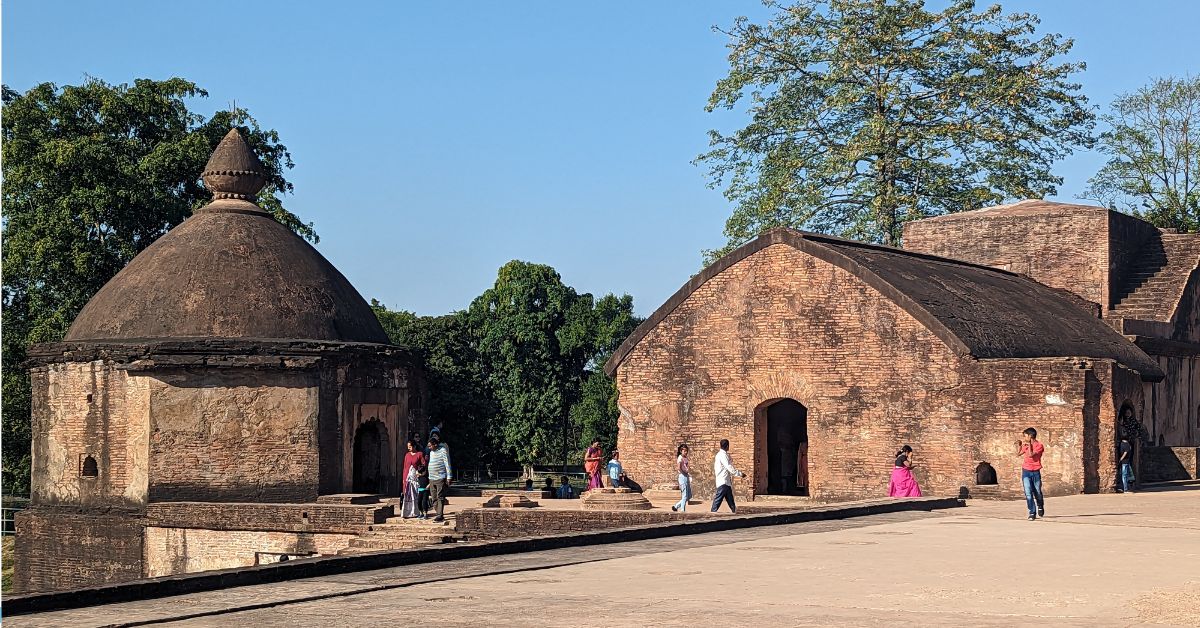Nestled within the historic town of Sivasagar, Assam, the Sivadol temple stands as a majestic testament to the region’s rich cultural and spiritual heritage. This magnificent shrine, dedicated to Lord Shiva, is more than just a place of worship; it’s a living embodiment of Assam’s royal past and architectural brilliance.
Built in the 18th century by Queen Ambika, Sivadol, or the Siva Temple, is renowned for its distinctive architectural style. Its towering structure and intricate carvings bear the unmistakable imprint of the Ahom dynasty, a reflection of their profound influence on the region’s art and culture.
How to reach:
- By Air: The nearest airport is Jorhat Airport (JRH), approximately 55 kilometers from Sivasagar. From the airport, you can hire a taxi or take a bus to reach the town.
- By Train: The closest railway station is Sivasagar Town Railway Station (SVY), well-connected to major cities like Guwahati and Dibrugarh. Taxis and auto-rickshaws are readily available outside the station for onward travel.
- By Road: Sivasagar enjoys good road connectivity. State-run buses and private taxis operate regularly to the town from nearby cities like Guwahati (around 360 kilometers) and Jorhat (about 55 kilometers).
Best time to visit:
Winter (November to February)
Winter offers pleasant weather, perfect for exploring the temple and its surroundings. Clear skies enhance the beauty of Sivadol’s architecture. This season also coincides with major festivals like Maha Shivaratri, providing a vibrant cultural backdrop.
Spring (March to May)
Spring brings warmer temperatures and blooming landscapes. While crowds are fewer compared to winter, the weather becomes gradually hotter.
Monsoon (June to September)
Monsoon brings heavy rainfall, making outdoor activities challenging. However, the region becomes lush and green.
Autumn (October to November)
Autumn offers pleasant weather with clear skies, making it a good time to visit. Cultural events and festivals may add to the experience.
Attractions:
Sivadol (Shiva Temple):
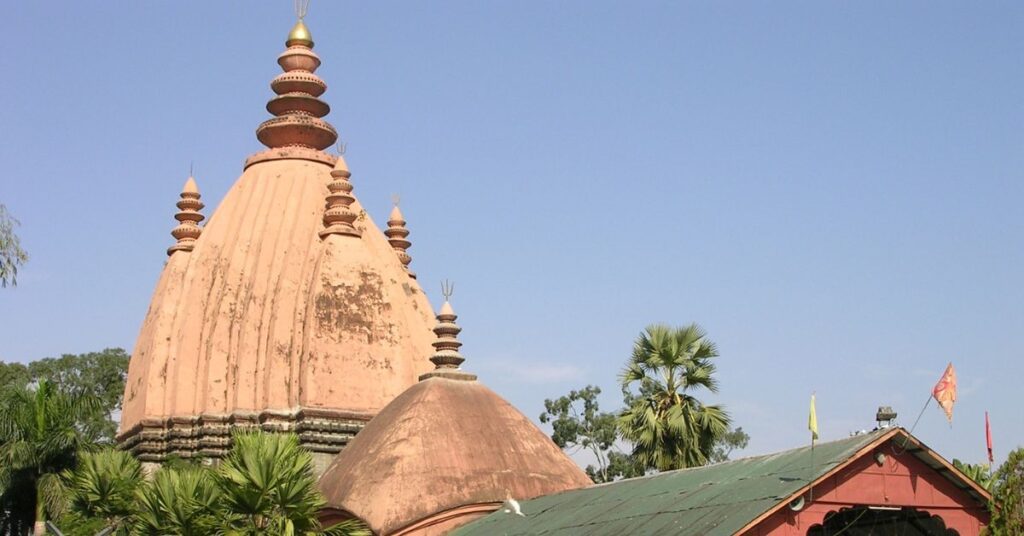
Sivadol, a majestic temple dedicated to Lord Shiva, stands proudly on the banks of Sivasagar Tank in Assam. Built in 1734 by Queen Ambika, it’s a remarkable example of Ahom architecture. The temple’s towering 104-foot structure, adorned with intricate carvings, culminates in an eight-foot golden dome. Every year, the vibrant celebration of Maha Shivaratri transforms Sivadol into a spiritual hub, attracting devotees and tourists alike. It’s a powerful symbol of Assam’s rich cultural and historical heritage.
Rang Ghar:
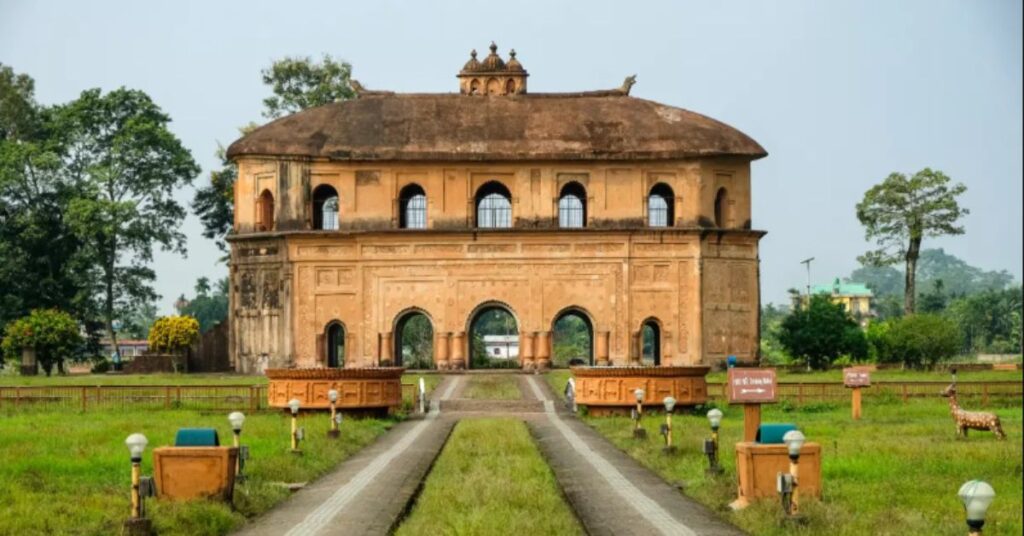
Rang Ghar, often hailed as the “Colosseum of the East,” is an ancient amphitheater situated near Sivadol. Built during the reign of Swargadeo Rudra Singha in the mid-18th century, this two-story structure served as a royal pavilion for the Ahom kings to enjoy sports and cultural events. With its unique inverted boat-shaped roof and intricate elephant sculptures, Rang Ghar showcases the Ahom dynasty’s architectural brilliance and their passion for entertainment. Today, it stands as a proud symbol of Assam’s rich cultural heritage, captivating visitors with its historical charm and architectural beauty.
Kareng Ghar:
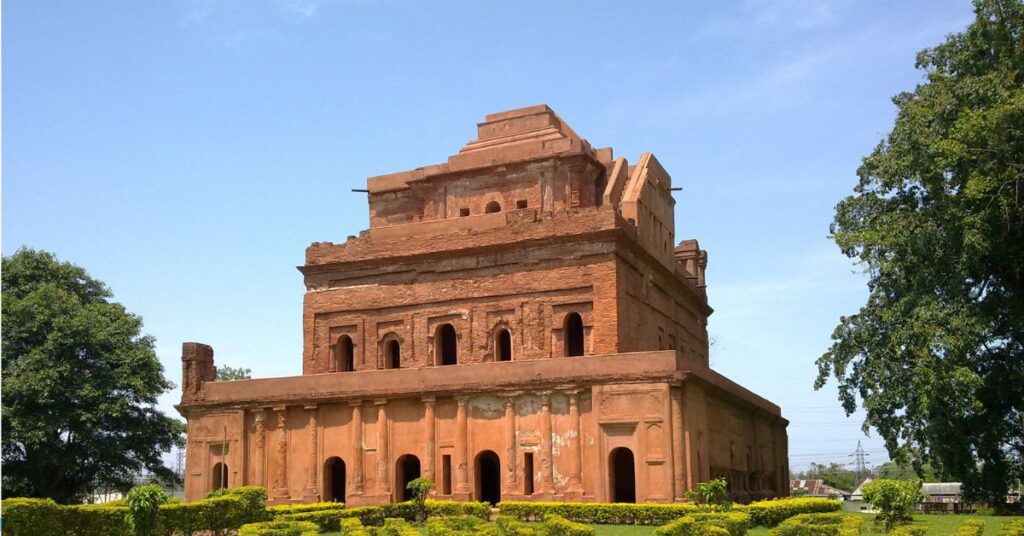
Kareng Ghar, or the “Palace of the Royals,” was once the grand residence of the Ahom kings. Located in the heart of Sivasagar, it stands as a testament to the architectural prowess of the dynasty. This multi-storied palace boasts spacious halls, intricate balconies, and even underground passages, offering a glimpse into the opulent lifestyle of the Ahom rulers. Built in the 17th century by King Rudra Singha, it also served as the kingdom’s administrative center. Despite the passage of time, Kareng Ghar retains its majestic aura, offering visitors a window into the world of Ahom royalty.
Talatal Ghar:
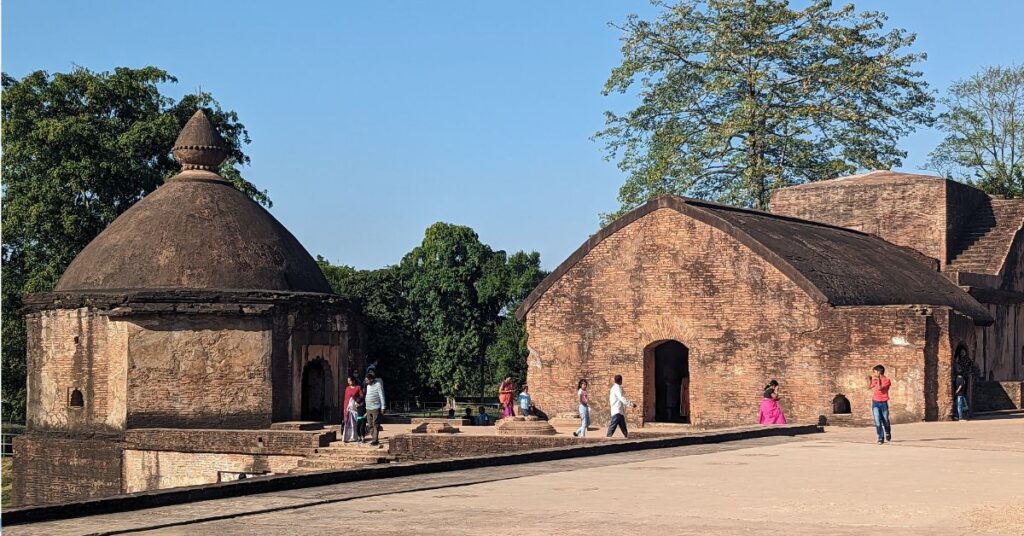
Talatal Ghar, an underground marvel, is one of Sivasagar’s most intriguing structures. Built by Swargadeo Rajeswar Singha in the 18th century, this seven-story palace features three underground floors. Originally used as military barracks and escape routes, the palace’s intricate design with hidden tunnels showcases the Ahom dynasty’s strategic brilliance. The upper floors served as the royal residence, adorned with exquisite carvings. Today, Talatal Ghar stands as a testament to the Ahom rulers’ ingenuity and remains a popular attraction for those fascinated by history and architecture.
Local Experiences:
- Experience vibrant festivals like Maha Shivaratri and Bihu.
- Savor the flavors of authentic Assamese cuisine.
- Discover local artistry at handicraft markets.
- Enjoy a peaceful boat ride on Joysagar Tank.
- Witness captivating cultural performances.
- Connect with local artisans.
- Explore lush tea gardens and savor local tea.
- Immerse in rural Assamese life.
- Uncover the region’s history at the Sivasagar Museum.
- Embark on birdwatching and nature walks.
- Explore bustling local markets.
Travel tips:
- Currency: Carry Indian Rupees (INR) as cash, especially in smaller towns. Card acceptance and ATMs may be limited.
- Language: Learn basic Assamese or Hindi phrases. English is widely understood in tourist areas.
- Connectivity: Ensure your mobile plan works in Assam or consider buying a local SIM card for better coverage. Wi-Fi might be limited in rural areas.
- Local Travel: Use auto-rickshaws, cycle-rickshaws, or taxis for local transport. Negotiate fares upfront.
- Trains and Buses: Book tickets in advance, especially during peak seasons and festivals.
- Airport Transfers: Arrange a taxi or pre-booked transfer from Jorhat Airport to Sivasagar.
- Booking: Reserve accommodation in advance, especially during peak seasons.
- Location: Choose accommodations near major attractions for convenience.
- Hydration: Stay hydrated, especially in warmer months. Carry a reusable water bottle.
- Insect Protection: Use insect repellent to protect against mosquitoes.
- Healthcare: Familiarize yourself with local healthcare facilities.
- Cultural Sensitivity: Dress modestly when visiting temples. Respect local customs and ask for permission before photographing locals.
- Guided Tours: Consider hiring a local guide for deeper insights into the region’s history.
- Historical Context: Research the Ahom dynasty and Sivasagar’s history for a richer experience.
- Food Safety: Prioritize fresh, hot food and drink bottled water.
- Local Markets: Explore markets for authentic Assamese crafts and souvenirs.
- Tea: Bring home the taste of Assam with locally sourced tea
Conclusion
Sivasagar, a historic gem in Assam, beckons travelers with its rich cultural tapestry. This enchanting town offers a captivating blend of past and present. Majestic structures like Sivadol temple, Rang Ghar, and Talatal Ghar stand as architectural marvels, echoing the grandeur of the Ahom dynasty. The serene Joysagar Tank and the royal legacy of Charaideo add to the town’s allure. Beyond history, Sivasagar delights with warm hospitality, delectable cuisine, and vibrant festivals. Whether you’re a history buff or simply seeking a peaceful retreat, this town promises unforgettable experiences. Plan your visit with Xplro.com and immerse yourself in Assam’s royal heritage.
FAQs
When is the ideal time to visit Sivadol?
- The best period to visit Sivadol is during the winter months, from November to February, when the weather is pleasant and perfect for sightseeing.
What are the ways to reach Sivadol?
- Sivadol can be reached by air, train, and road. The nearest airport is Jorhat Airport, around 55 kilometers away. Sivasagar Town Railway Station connects with major cities. Buses and taxis are available from nearby cities like Guwahati and Jorhat.
What are the top attractions in Sivadol?
- Major attractions include Sivadol (Shiva Temple), Rang Ghar, Kareng Ghar, Talatal Ghar, Joysagar Tank, Charaideo, Gargaon Palace, and the temples around Sivadol Tank.
What should I wear when visiting Sivadol?
- Wear comfortable clothes suitable for the season. When visiting temples, dress modestly and remember to remove your shoes before entering.
Which festivals are celebrated in Sivadol?
- Sivadol celebrates festivals like Maha Shivaratri at Sivadol, and the Bihu festivals (Rongali, Bhogali, and Kongali), among other local cultural festivities.
Is vegetarian food available in Sivadol?
- Yes, vegetarian food is readily available. Many restaurants serve traditional Assamese vegetarian dishes as well as other Indian vegetarian cuisine.
What local dishes should I try in Sivasagar?
- Some local delicacies to try include khar (an alkaline dish), masor tenga (a tangy fish curry), pitha (rice cakes), and traditional Assamese thali.
Is Sivasagar a safe destination for tourists?
- Sivasagar is generally safe for tourists. However, it’s wise to take standard precautions, such as avoiding deserted areas at night and being mindful of your belongings.
Are guided tours available in Sivasagar?
- Yes, you can find guided tours. Hiring a local guide can provide deeper insights into the historical and cultural aspects of the attractions.
Where can I buy traditional Assamese handicrafts in Sivasagar?
- You can purchase traditional Assamese handicrafts, including silk sarees (mekhela chador), bamboo crafts, and pottery at local markets and craft centers.
What types of accommodation are available in Sivasagar?
- Sivasagar offers a range of accommodations, from budget hotels and guesthouses to mid-range hotels. It’s advisable to book in advance, especially during peak seasons.
Do I need any special permits to visit Sivasagar?
- Indian tourists do not need any special permits to visit Sivasagar. International tourists should ensure they have valid passports and visas.




